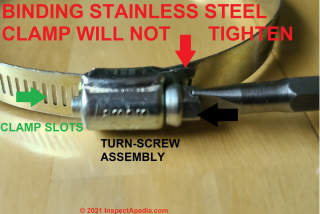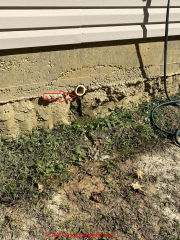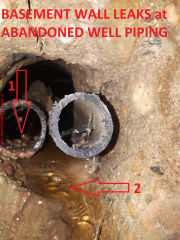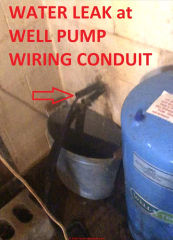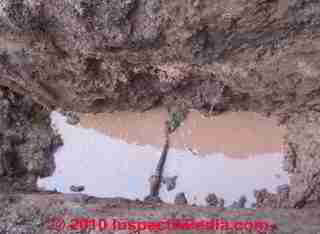 Well Water Piping Leak Diagnosis & Repair
Well Water Piping Leak Diagnosis & Repair
Symptoms of well piping leaks
- POST a QUESTION or COMMENT about how to detect, find, and repair leaks in water well piping
Diagnose well pipe leaks:
This article describes diagnosing and repairing leaks that can occur in building water piping between a private well and the building water equipment.
We also discuss the diagnosis and repair of leaky water well casings themselves. Knowing just what kind of leak is occurring in a building helps pinpoint the problem and also helps specify the necessary plumbing repair.
We provide a simple guide to the types of leaks that occur in water pipes, drain pipes, & plumbing fixtures. Causes of well piping leaks. Causes of well casing leaks. The Old House Repair "Spaghetti Problem" - where do we stop? What Causes Leaks in Buried Well Water Piping? Characteristics, diagnosis, & repair of well casing leaks.
The articles at this website will answer most questions about diagnosing and repairing pumps, wells, water supply systems, and building piping. Our page top photo shows water around a plastic water line that had a buried but leaky fitting. The repair was simple, but the excavation to find the leak was a bit more trouble.
InspectAPedia tolerates no conflicts of interest. We have no relationship with advertisers, products, or services discussed at this website.
- Daniel Friedman, Publisher/Editor/Author - See WHO ARE WE?
Well Piping Leaks - How a Hidden Water Leak Causes Various Problems
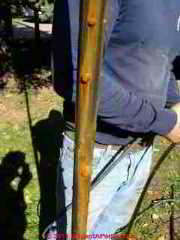 Well piping leaks vs well casing leaks:
Well piping leaks vs well casing leaks:
Here we discuss diagnosing and repairing leaks in the well piping that extends from the well bottom foot valve or pump in to the building where it is typically connected to a pressure tank, pump controls, and the building water supply piping.
For well casing leaks
(leaks in the large diameter steel pipe or casing that lines the well bore)
see WELL CASING LEAK REPAIRS
Water will leak out of a well pipe
at a bad connection, perforation, or cracked pipe when the well pump is running, particularly if the water system uses a submersible pump that is located in the well itself.
If you have this problem you may find a wet spot in the ground near the well piping, provided that the pipe is close enough to the surface.
You will also notice that the well pump is running more often than normal, and that your "apparent" water usage may have increased.
Some people even report finding a "water fountain" or geyser in the lawn at a burst water supply pipe from both private wells and from a municipal water main.
Article Contents
Signs of Well Pipe Leaks: Air Discharge at Plumbing Fixtures or Intermittent Pump Cycling May Indicate A Well Piping Leak
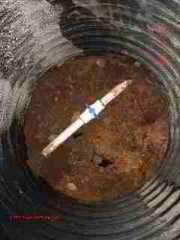 Air may leak into a well water pipe
Air may leak into a well water pipe
at a bad connection, perforation, or other damage when the well pump stops running, particularly if the leak problem is combined with a defective check valve or foot valve in the piping system.
The result may be air discharged from plumbing fixtures, improper air charge in the water pressure tank, or loss of pump prime. Short cycling of the water pump or loss of pump prime may result as well.
See AIR DISCHARGE at FAUCETS, FIXTURES
The corroded galvanized iron well pipe shown at above left is discussed in more detail
at INTERMITTENT CYCLING WATER PUMPS.
Photo by DJF & Rasmussen Well Drilling, Inc.
This water pressure diagnosis problem discussion below gives some added details, thanks to reader Dan Babb.
Question - Excessive Well Water Use:
My house was built in 1979, but the well was re drilled to 142 feet in 1986 by the previous owner.
The copper pipes were replaced with pvc and a peroxide treatment system was installed due to the sulphur content. I purchased the property in 1997 and the last two years have been a journey.
I've replaced the well pump, pressure tank, pressure switch, chemical feeder pump, repacked the sand and charcoal filters.
Currently, I'm using twice the amount of chemicals to treat the water then a year ago. If I'm using twice the amount of water that would be acceptable. I have now flow meter for proof, but that can't be.
Culligan has been out three times to confirm the feeder and filters are functioning correctly.
I have not found any leaks, but have noticed an incredible increase of air within the system if it has been idle. There is no check valve on the system near the pressure tank.
Would a failing check valve in the well cause this issue? Should I install a check valve prior to the pressure tank? If i installed a flow meter, where should it be located?
Answer: Quick Tips on Diagnosing High Water Use, Pump Short Cycling, Air in Water Lines
Air in the system could be a piping leak - including between the well and the building - or the well running dry. Or a bad foot valve if the pump is in the building not in the well and a foot valve is all you've got in the well. That'd also show up as lost prime.
If you see the water pressure dropping after the pump has shut off and if you are sure no water is running in the building, then there is either a leak in the well piping or a bad foot valve. If the pressure does not drop, a check valve won't fix anything.
If the pressure is dropping, try a check valve as you suggest - if nothing else, it'd be diagnostic.
Watch out: As the feedback discussion below exemplifies, the second you start touching old plumbing in a building you may find out that there are multiple problems.
We call this the spaghetti problem: you can't pull just one strand of spaghetti out of the colander once it has all stuck together. That's characteristic of performing repair work on an older home.
Feedback on What Happened with Diagnosing a Well Problem: Multiple Water Supply Problems at One Shot
My system is now fixed. It was a combination of issues, but your diagnostics was correct. The air was a result of a leaking line at the well casing. After receiving your email, I looked over all the lines in the house.
No leaks could be found, but I could hear the well pump kicking on and off.
I began to monitor the pressure gauge at the pressure tank. The well would pump up to 50 psi and shut-off, then the pressure would slowly drop. I could hear water moving in the lines, but no faucets were on.
I shut the gate valve upstream from the pressure tank and pressure continued to drop. I noticed sweating on the pressure tank.
I turned off the pressure switch, closed a gate valve and opened the drain valve. The pressure tank drained very little water, but released the pressure. Seeing sweat half way up, I shook the tank and to confirm water was inside. The bladder had ruptured. I replaced the pressure tank, tee, and fittings and included a check valve downstream of the pressure tank.
I put the system back on-line. Air was still in the lines, so I decided to water the lawn , flowers and garden hoping to remove any trapped air from the system. It seemed to work.
Then I noticed the flowers around the well casing weren't suffering from the heat.
Taking a closer look there were puddles. I began touching the ground and it was saturated. I called my well driller and he came out and confirmed the water was leaking outside the casing.
He dug around the casing to reveal two pin holes in the 1" HDPE pipe. We spliced a two foot section and tested the system.
The well line is all fixed. I asked the plumber to look at my connections at the pressure tank. We added an air release valve and increased the pressure switch settings. I am very happy with the results.
My day wasn't over though.
I noticed water on the garage floor by one of my two 82 gallon holding tanks. There was a rusty look to the water. I tilted the tank and sure enough there were three streams coming from the bottom of the tank.
It may have been slightly leaking before, but the increased pressure possibly made it worse. I called Culligan and they no longer install galvanized steel tanks on sulphur systems.
Fiberglass tanks are now available for $460.
I'm currently testing my system on one tank and shopping around for best prices on fiberglass tanks.
Steps in Finding the Point of Leakage in Well Piping
Reader Question: how can I confirm that there is a leak in my well piping & how can I find where the leak is located?
(July 2, 2015) Anonymous said:
how can i check and see if i have a hole in my line before i pull the pump
26 July 2015 Anon-2 said:
How can I find where the leak is located between the house and the well?
Reply:
Anon:
If you shut off water into the building and water pressure falls at the pressure tank and well piping system then there may be a hole in well piping or a leaky foot valve or bad check valve at the pump.
Anon-2:
Turn off water on the house side of your well pump and pressure tank. Watch the water pressure gauge - presuming the gauge is on the well-side of the water valve you closed. If over a few minutes to a few hours you see the water pressure fall then it's a good guess that the leak is between the valve you closed and the bottom of water piping in the well.
Unfortunately the leak can be anywhere in that entire route.
Before launching a massive digging campaign, well service company or plumber may at this point look for
- A wet area developing anywhere along the route of the well piping often is a telltale for a leaky well pipe.
- A leaky foot valve or check valve at the well piping bottom or anywhere in the well piping system. Another symptom of a leaky foot valve is loss of well prime or occasional cycling on of the well pump when no water is being run.
- A leak at the pitless adapter where the well piping leaves the well casing
- A leak in the vertical well piping riser inside the well, a condition that might be detected by opening the well cap and observing or hearing water squirting or splashing when the pump is running
If none of these first steps find the well leak then there are a couple of options:
- Some well piping, depending on diameter, routing, location, can be inspected by insertion of an inspection camera.
- An excavator may begin at a most-suspect location (rocky soils, wet areas, areas where pipes are shallow or exposed to freezing, known lengths of older or metal well piping) and excavate along the well line until she or he sees water running into the excavation trench. At that point the leak is nearby.
- In some piping installations it may be possible to narrow down the range of piping where a leak is occurring using a mechanics' stethoscope.
What Causes Leaks in Buried Well Water Piping?
A variety of installation errors can cause a later leak in plastic well piping. We list some of these below, starting with an updat/plumbing/Well_Pipe_Leaks.phpPipe_Leaks.htm">WELL PIPING LEAK DIAGNOSIS from reader Dan Babb.
While the comments below describe the cause of a leak in plastic well piping, the same conditions can cause a leak in buried municipal water supply piping between the building and the street. As Carson Dunlop's Home Reference Book points out,
Poor water pressure in the house may be the result of a partially closed or obstructed valve in the street. It may also be because of blockage, such as a stone or other foreign body in the pipe. New piping may be crimped during installation or become pinched under a rock during back-filling operations. This can also cause low water pressure.
If your building is served by municipal water, not a private well,
and WATER PRESSURE LOSS DIAGNOSIS & REPAIR
and PIPING in BUILDINGS, CLOGS, LEAKS, TYPES.
Causes of Damage, Leaks, or Crimps in Buried Plastic or Metal Well Water Piping
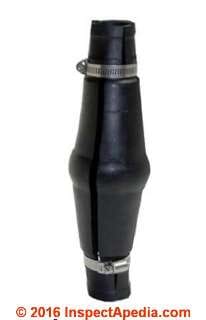 Illustration: a rubber torquer arrestor for use on well piping to control twist or torque damage to well piping and wiring in well casings.
Illustration: a rubber torquer arrestor for use on well piping to control twist or torque damage to well piping and wiring in well casings.
[Click to enlarge any image]
- Plastic well (or water main) piping damage during installation:
What caused the well piping leak that we describe above? My soil is 18"-24" black topsoil, then sandy, silty clay soil. No rocks or sharp objects were found. We were careful digging around the line.
We checked about 10 foot of line, but only found leaks near the fitting at the casing.
After removing the leaking section, I cleaned it up for further investigation. It appears to me the pinholes were a result of careless installation work. The pipe exterior surface had cuts and nicks where the pinholes were. What people may not know is that HDPE pipe needs to be slightly heated to fit over the fitting.
If it's overheated it could change the integrity of the pipe.
The previous installer may have overheated and nicked the pipe with the clamps or a screwdriver.
Maybe they didn't know the pipe needed heat and used brute force with pliers or channel locks to slip it over the fitting. - Overheating plastic piping
during joint fitting can chemically change the plastic, making it brittle and crack prone near the connector - Under heating plastic piping
during joint fitting can cause the pipe to crack when it is forced over a fitting or connector - Under-tightening metal connector parts
such as hose clamps often leads to immediate or near-term leaks in the well piping connector. If you are having trouble making the connector tight-enough you may need to replace the hose clamp.
See details at PIPE / HOSE CLAMP LEAK REPAIR - Over tightening metal connector parts
such as hose clamps can (rarely) crack or crimp a pipe or fittings or you may damage the clamp so that it won't tighten properly.
- Burying plastic piping with soil containing sharp rocks
can lead to later puncture and leaks - Driving over piping
that is not properly bedded in sand or not buried at a safe depth can cause leaks in piping - Holes in the well pipe from abrasion or mechanical damage:
Defective well piping, corrosion of metal piping (see photo near page top), or plastic piping that rubbed on a rock or other obstruction can lead to a hole in the piping that leaks water out when the well pump is running and leaks air into the system when the pump stops.
The well piping as well as well pump wiring can be abraded and damaged by torquing or twisting of the well pipe inside the well bore or casing at each submersible pump on-off cycle.
See SUBMERSIBLE PUMP TORQUE PROBLEMS & SOLUTIONS for help stopping well pipe twist or torque damage problems.
For a discussion of piping movement, abrasion, and well pipe torquing causing well pump wiring damage
see WATER PUMP WIRING REPAIR
At AIR DISCHARGE at FAUCETS, FIXTURES and
At WATER PUMP SHORT CYCLING CAUSES we discuss the role of a bad check valve or a hole in the well piping in causing well pump short cycling - water and pressure are lost through the leak when the pump runs, and air may enter the piping when the pump stops - depending on where the leak is located.Leaks in "hidden" air volume controls located on well piping on certain submersible pump systems using a bladderless water pressure tank are discussed
at AIR VOLUME CONTROLS, WATER TANK. - Pitless adapter leaks
due to gasket wear or fitting leaks -
See PITLESS ADAPTERS - Foot Valve Leaks - check
See FOOT VALVES, WELL PIPING - CONTACT us to suggest other leak causes in plastic or metal well piping
Inspect your connections carefully with the well piping under full pressure before burying the water piping.
Also see WATER SUPPLY/DRAIN PIPE LEAK TYPES
and see THAWING FROZEN PIPES which addresses how to find frozen and burst pipe leaks in buildings, and
see REPAIRING BURST LEAKY WATER PIPES
If the water supply piping inside your building is also plastic,
see PLASTIC PIPING ABS CPVC PB PEX PPR PVC.
If your building is served by municipal water, not a private well, see
- PLASTIC PIPE LEAK CAUSES and
- MUNICIPAL WATER PRESSURE DIAGNOSIS and
- PIPING in BUILDINGS, CLOGS, LEAKS, TYPES.
At WATER PRESSURE PROBLEM DIAGNOSIS TABLE we note that a possible explanation for loss of building water pressure, or loss of well pump prime can be air leaking into a well piping line, as well as water leaking out of the well pipe.
...
Reader Comments, Questions & Answers About The Article Above
Below you will find questions and answers previously posted on this page at its page bottom reader comment box.
Reader Q&A - also see RECOMMENDED ARTICLES & FAQs
On 2021-09-02 by Jay - well casing vent hose leading to basement flooding
I have water coking into my basement from the well's rubber vent hose.
The first time this happened it was after a large storm (with lots of precipitation) once the electricity had been restored. I was told that my well is entombed and therefore needs the vent hose - what I am not clear about is why the vent hose comes into the basement from an exterior wall.
My plumber replaced the check valve and it has been working okay for 6 months. Last night we again had a significant storm with multiple inches of rain. No water in the basement until power was restored and the well pump was turned back on) and then water started running through the vent hose like an open faucet
Plumber is on vacation so I just connected a garden hose to the vent hose and have the water exiting through the walk out basement door to keep my basement dry.
I can't seem to find any information about vent hoses leading to basement flooding - hoping that the water table is just high and after a while all of this water will stop. Can anyway share knowledge about this? Thanks in advance.
On 2021-09-03 by inspectapedia.com.moderator (mod) - basement water entry source report: well vent back-flooding into the building.
@Jay,
Thank you for that basement water entry source report: well vent back-flooding into the building.
It's one I've not come across before, but it makes perfect sense in that some water wells whose water level is normally somewhere down in the casing can fill right to the casing top if the well floods during wet weather.
Depending on your well's installation and casing details it would make sense that the vent was routed into the building.For example if a well casing needs to be vented and its top is buried (not something we like to do with new drilled, steel-casing wells), then the vent exit port needs to be in an area where it's protected from snow-cover and from dirt or debris entering the well through that opening.
It's fine to temporarily drain your well vent to the outdoors to avoid a basement flood from that source, though I'd not want to leave a hose hooked-up full time, because I worry that the venting - allowing air into the well as water level drops during normal pumping) could be restricted by such a hose-extension.There could be subtle well sanitation issues from using the garden hose too.
I have a second concern: the sanitation of your well during wet or flooding conditions.
If the well water level rises because its native aquifer increases the aquifer itself may be getting flooded with un-sanitary ground-water or surface runoff; there is a second possibility that surface runoff is leaking into the well at the well casing top or at a leaky pitless adapter - again only during flooding conditions or very wet weather.
So you should have your well water tested; the minimum would be a bacteria test as that's not a bad marker for surface water contamination.
On 2021-09-19 by Jenn
@Jenn, 'It goes to 60 and then immediately drops to 56'
There's a very slow loss of pressure on our system (set to 40-60). We are certain nothing is calling for water in the house. When the pump comes on, it goes to 50 and then immediately drops to 56, and then slowly drops to 40 (takes about an hour). Our water is dirty.
The article talks about water leaking out, and then air coming in, on a leak in the line between the house and well.
Could sand/silt come in as well? We're trying to isolate the source of the dirt. It would be a nightmare to locate the leak on the line - it's about 400 feet from house to dug well.
On 2021-09-19 by inspectapedia.com.moderator (mod) - Could sand/silt come in as well?
@Jenn,
A leak can be anywhere from the pump to the foot valve at the bottom of the piping in your well.
Often, because it's easier, a repair service will try replacing a foot valve before digging up the entire well line. As we discuss above, it is sometimes possible to find the area of leakage without extensive excavation by finding wet areas along the route of the well piping.
It's possible for a leak in well piping to cause soil to appear in the water supply, but most often is coming from the well itself, either from a damaged casing or if the water level in the well is low.
On 2021-09-19 by Anonymous
@inspectapedia.com.moderator, Thanks for you quick response. It's a 3 foot diam. dug well about 14 feet deep with about 7 feet of water. It has a submersible pump with a built in check valve - there is no foot valve. The well was recently cleaned (dug out about a foot of sand at the bottom).
We have flushed water out of the well 6 times i.e until the pump runs out of water. Let it sit overnight to replenish and run down again.
Now, looking at the water discharge in the house (the spigot beside the pressure tank).
When the pressure is at 60, water run off is dirty. Let it run down to 50 and it starts to clear up.
By the time it's down to 40, it's quite clear. The pump comes on, we turn off the spigot and let it charge to 60. Open the water and it's dirty again - etc. Don't understand why we get a spurt of dirty water at the high pressure end.
On 2021-09-19 by inspectapedia.com.moderator (mod)
@Anonymous, @Jenn,
I've seen this problem when there is sediment already in the well piping. When we pump suddenly at higher pressure it picks some of that up and flushes it through.
Of course that's not the only possible explanation.
Disturbance of water and silt at the well bottom when the pump comes on could also be a dirt source.
You may be able to improve a problem by raising your pump's water pickup point another foot or more off or above the bottom of your well.Continuing
If your submersible pump is actually in the well then you may need to replace a check valve in the pump itself.
@Jenn,
Also, you may find a plumber or other specialist who can help find the leak using leak detection equipment.
On 2021-09-19 by Jenn
@inspectapedia.com.moderator, Thanks for your thoughts; will try raising the pump.
On 2021-09-19 by (mod)
@Jenn,
Sounds right, do let us know what happens.
On 2021-09-02 by Mike K - leaking appears to be coming from the concrete where the well pipe comes into the house
I have water leaking into my home from around the well pipe that runs from my well to the holding tank.
The leaking appears to be coming from the concrete where the pipe comes into the house or from the pipe that is covering the incoming water pipe. Can this be easily repaired or is this a major fix?
On 2021-09-02by inspectapedia.com.moderator (mod)
@Mike K,
Sorry to say I just don't know - from your brief text we don't know the cause of the leak nor what excavation or other repair work is needed.
It sounds as if there is a leak outside your home - that could be in the water pipe itself, meaning it needs repair or replacement - which if buried can be a pretty big job;
OR
You could have water spilling off your roof in rainy weather - roof spillage that collects around the foundation will often find a way in at foundation penetrations like at a water pipe.
If you have had no rain and it's dry then I suspect a pipe leak.
On 2021-06-16by dickey8116@gmail.com - well cap pipe keeps blowing apart
The pipe that comes out of the well cap keeps blowing apart at the bracket tightner at the 3 elbows why?
On 2021-06-16 by inspectapedia.com.moderator (mod) - What causes well piping sections to blow apart at connections?
@dickey8116@gmail.com,
Thanks for an interesting, if troubling question that I'd re-state as
What causes well piping sections to blow apart at connections?
Contextual Details Needed to Answer Pipe Connection Failure Questions
To make a more-accurate answer it would be useful to know
- What is the piping material?
I'm going to assume you're using ABS water piping with stainless steel clamp connectors - What is the range of operating pressures
of your pump and its pressure control switch? You should be able to read the low pressure point or CUT-IN pressure by running water in the building and watching the pressure gauge; You can observe the CUT-OUT pressure by then turning off water and taking note of the gauge pressure when the pump stops.
Watch out: for an inaccurate gauge if the numbers don't seem reasonable or if the gauge doesn't respond immediately to changes in water pump operation and water use and thus to system pressure.
See details at WATER PRESSURE GAUGE ACCURACY
See WATER PRESSURE CONTROL SWITCH, PUMP - if you need help identifying or understanding how that control works - What surrounding observations can you make
that might be a clue about pipe connection failures such as
3.a. What's the history of well piping age and repairs?
Have some of those leaky connectors been repaired multiple times?
3.b. Is a banging sound or water hammer occurring
when water is turned on or off or when the pump turns on or off?
See details at WATER HAMMER NOISE DIAGNOSE & CURE
What to Check Next
I would check these pipe connection failure causes in this order:
- If the system operating pressure is over 70 psi it's too high
for typical residential piping systems, and leaks are likely; - If there is water hammer
that can blow apart pipes at connections and needs to be addressed. We gave the more-info leak above - If your plastic connections are made using a single hose clamp
I would use two clamps at each of those locations and be sure they're tightened securely.
Watch out: don't over-tighten so much that you deform or crack the plastic connector, and don't over-tighten when the ABS is still soft from being heated - you'll see this is a problem if you see the stainless steel clamp cutting deeply into the black ABS well piping plastic. - If well piping connectors or parts have been re-used
particulary ABS piping and plastic connectors, those often fail on re-use, both because the heated ABS piping, heated to soften it so that it can be pushed onto the plastic connector or elbow is itself deformed and weakened and no longer seals well against the ribbed plastic connector, and also because the ridges on the plastic connector have been smoothed and no longer grip the pipe.
Solution: cut off that over-heated and deformed ABS back to good piping, use new plastic connectors and re-make the leaky or unreliable connections. - If there are threaded NPT fittings
those too may be stripped worn from repeated re-use or over-tightening.
Solution: use new threaded fittings; don't over-tighten; use pipe sealant or teflon tape; and if you're using galvanized iron or copper threaded fittings, those too can be damaged by over-tightening;
Don't forget to check the well cap itself to be sure that its threaded openings are not stripped. - Something else:
It's possible, from your brief text, that we've misunderstood exactly what's failing; if so let's be more detailed, and perhaps you can attach a photo of the failure or the failing parts. (One photo per comment, as many photos and comments as you like).
If you're referring to the expanding seal used in some well casing tops
that seals the casing top by squeezing a thick rubber washer between two iron plates (by tightening bolts through the plates) that's a different topic and a different set of causes - such as well pipe twisting from a submersible pump; let us know.
On 2020-11-28 by bruce crowley - pump seal causing all air bubbles
can my pump seal be causing me to get all air bubbles when I try to prime my pump
On 2020-11-28 by (mod)
Sure if it is leaking - air can leak in to the well pump at a bad gasket or bearing seal
On 2020-11-10 by Bobbi - well pump doesn't come on after leak repair
When to turn on water if pump isn't engaging after leak is fixed?
On 2020-11-10 by (mod) - when to turn on the pump if we got no water after a leak is fixed.
Bobbi,
Once a pipe leak is fixed in the building you can turn on the well pump.
But if hte leak was in the well piping AND if the pump was a jet pump you need to re-prime the pump.
If that's your situation
see WATER PUMP PRIMING PROCEDURE
Watch out: if you turn on the pump and no water is delivered, turn it back OFF right away. If you run a pump dry you can damage it.
in the article index take a look at the articletitled WATER PUMP WON'T START
Or see the diagnostic steps
On 2020-10-04 by Chasity Maudlin - water coming out of pipe sticking out of neighbor's wall
My neighbor has a pipe that sticks out the side of the wall outside that is pouring water out of it. No water is on inside of the house and the well isn’t even running. The bathroom is behind the outside wall
On 2020-10-04 - b (mod) - check for a sump pump in a wet basement
Chastity
We don't know if this is an illegal discharge of bathroom graywater or a legal discharge from a sump pump
Even if it's from a sump pump that's part of a basement or crawl space de-watering system, it's a foolish thing to dump water right by the foundation wall as it simply wants to come right back into the building.
On 2020-09-01 by diana wilson - what's the cost to dig up a pipe
cost to dig up the elbow joint of a well 18: down and replace same.
On 2020-09-02 - by (mod)
Diana
Plumbing and well piping service costs vary significantly depending on where you live, ease of access to the site, and what equipment is necessary.Hand digging a small 18in deep hole to fix a simple elbow in a pipe could be as little as a few hundred dollars.
Bringing in a backhoe even for just a few hours can be ten times that amount.
On 2020-08-12 by Pete Timpson - leak at well pump plastic pipe connection
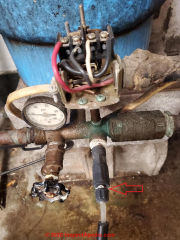 After I replaced my pressure switch water was dripping out of the hose that is directly below the gauge in the photo. What is that hose called?
After I replaced my pressure switch water was dripping out of the hose that is directly below the gauge in the photo. What is that hose called?
On 2020-08-14 - by (mod) - leak at plastic piping at ater tank
Pete
That looks like a small diameter plastic tube that must be feeding water to something: perhaps a water purification device or a disinfectant injection system- follow the plastic tubing to see where it goes;
To replace parts you'd simply turn off water, remove water pressure from the system, and take the old parts to your local plumbing supplier.I suspect you banged or disturbed that small plastic fitting while replacing your pressure control switch, causing it to leak.
Watch out: hand tighten those parts only - using a heavy wrench or pliers can crack a part and lead to a big leak.
On 2020-07-13 by Anonymous - Can a leak between the house be the cause or contributor of lots of air in the water faucets?
Can a leak between the house be the cause or contributor of lots of air in the water faucets and a hammering of the pipes. It’s gotten worse.
Also had a new well pump put in two years ago. The old one functioned reliably for over 26 years and had to be replaced because it got hit by lightening.
It seems ever since that new pump has been installed my water supply is just terrible. I called the installer who is now retired and he said he has never had that problem with any of his hundreds over 26 years in that business. My well is 540’ deep drilled and is also mega high in radon and uranium. Sign me worried and feeling lost. Eileen
On 2020-07-13 - by (mod) - air discharge and water hammering noise caused by a pipe leak?
Anon
Thank you for askinga helpful question.
Yes in some circumstances a leak anywhere in the well piping systems can leak water out when the pump is running and yet it might draw air into the system when the pump is off.That in turn can result in a subsequent are discharged at fixtures.
See the diagnostics at AIR DISCHARGE at FAUCETS, FIXTURES
and
On 2020-07-08 by Mariah - seal leaks at abandoned two pipe jet pump well system
We just discovered a hole behind the drywall in the basement. There has been water coming in every time it rains.
It appears to be piped to the well that is outside. How can we fix this problem and why would they have this pipe coming into the basement with nothing connected to it?
On 2020-07-08 - by (mod)
Mariah
Thank you for the photo in the interesting abandoned well piping photograph. From your photo it appears to me that we are looking at the two ABS plastic pipes that would have been used for a two line jet pump bringing water from a deep well into the building.At some point The Pump and Well were abandoned, perhaps if the building changed to Municipal Water Supply.
Someone appears to have simply sawn off the pipes and left their exposed ends.
In that condition, especially in wet weather, if the water level rises sufficiently in your well or if it will becomes temporarily an artesian well, it may send water into the building through the wall, un-asked.
The solution is simple and trivial. You or a plumber would buy the appropriate fittings to cap and seal the two exposed pipe ends, the smaller of which, probably 1 1/2" (measure it) is leaking.
Above we show a NIBCO 1 1/2" ABS DWV piping cap that is an example of a seal that can be glued in place using solvent cement.Also available in other standard sizes such as 1" and 2" ABS.
Total cost, less than $5.00. for cap and adhesive solvent cement.
Watch out: it is quite apparent that there is water leaking into the building through the smaller-diameter of the two well pipes (arrow #1) , but there may be additional water leakage through the foundation wall at the cutout through which these pipes pass (arrow #2).
Often the ditch dug to lay well pipes forms a natural water-collection conduit that in turn sends water towards the foundation.
You may need to seal the entire opening around the pipes as well as capping the un-used well pipes.
And of course don't forget to check that the roof gutters or surface runoff are not aiming water at the building's foundation.
On 2020-07-01 by Robynne - find and fix leak between pump and house
I am in Sandy Oregon I have a leak between my pump house and my home it’s a block at least between the two I have to fill up my water tank and then walk out into the field to turn the pump house off. Enough . Who can come out here to detect the leak with equipment it’s tricky it needs a pro to discover where?
On 2020-07-01 - by (mod) -
Robynne,
You'll want to give a call to a local plumber, cinfirming that she or he works on well piping and controls.
You may ultimately need an excavator to dig up the well line, but first, confirm that the leak is not in or at the well.
On 2020-03-27 by KP2020 - how to find cause & fix drip coming from the top tube that links the well from the ground
Hi I turned on the water to my summer house and noticed a small drip coming from the top tube that links the well from the ground outside into my home and into the water pressure tank. It is not the main water tube it is the one above it that has the electric cord that runs to the pump.
There is a slow drip when the water is on coming from that top tube so I put a bucket underneath it. I called my plumber and he said I should call the well driller that installed the new pump six years ago.
The well driller came out and said there is a leak in the tubing in the ground outside and they would have to come and do a drill into the ground to find a location of the leak.
They want to charge me $1500 just to drill and look for the leak.
Then once they determine the cause of the leak they will let me what it would cost to fix it.
I am a single female and concerned that sometimes people may take advantage of someone who has no idea about this stuff.
Despite the cost, does this sound Like the right procedure?
The dripping has stopped it started getting slower and slower and now has stopped today and it happens to be 60°‘S and I’m wondering if the weather had anything to do with it leak - perhaps some thing was frozen in the ground and now it’s not and therefore it’s not leaking anymore? Thank you so much for your help ?
On 2020-03-28 - by (mod) - drip coming from the top tube that links the well from the ground
Can you attach some photos? 1 per comment.
On 2020-03-28 by KP2020 - emergency sealant for leaks at well pipe, conduit, or wall
Thanks pls see attached - the top tube is what has had a slow drip for last few weeks - but today is second day with no more drip at all . I have attached image
On 2020-03-28 - by (mod)
 KP
KP
That photo is a little hard to make-out, but it looks to me as if the upper "pipe" is conduit carrying an electrical wire. If you can follow the "wire" leaving that upper pipe to an electrical control, switch, or electrical box you can confirm that.
If that's the case, what we have is a buried electrical conduit that's leaking water into the home (and into the conduit);
If the wire (if it is a wire) run through the conduit isn't rated for buried or underground use (it'd be labeled UF for "underground feeder" or something similar) then it's particularly dangerous for it to be wet as there's a shock risk.
You could try plugging open pipe end around the wire to stop the drip, but that would not fix the leak into the conduit from somewhere outside. If the wire is safe being wet (right type) and un-damaged (who knows?) that outside repair may be less urgent.
A polyurethane foam (those like water) might work, or
You might even try a marine sealant like the one shown below.
On 2020-03-29 by KP2020 - well guy will dig to find leak
Thanks for the info. The well guy didn’t seem to think this was urgent but said they would have to dig up outside to find the source of the leak
It is the top tube that houses the electric wire. I think they will have to come do the dif it sounds like. Do you know why it would suddenly stop leaking ? Again, thanks for your help.
On 2020-03-29 - by (mod) - reasons why the well pump electrical conduit might stop leaking
KP
I can invent reasons why the well pump electrical conduit might stop leaking at the house wall.
- the groundwater source sending water into the conduit may have become reduced as weather changes
- the groundwater may be temporarily frozen
- mud and silt may sometimes infiltrate and clog or slow a water entry point into conduit
On 2020-03-30 by KP2020
Thanks very much. Just one more question, it is still worth it to have them come dig up outside right ? They should be able to determine the cause and fix it based on some of the reasons you gave for it suddenly stopping ?
On 2020-03-30 - by (mod) - safety of well pump wiring conduit
KP
I figure that if the underground conduit for electrical wire between pump and house was not needed the electrician wouldn't have installed it in the first place.So ultimately you want it to be intact and in safe condition.
An alternative that may be less costly would be to simply have a new wire, rated for underground use without conduit, installed between house and well top.The digging is done with a"ditch-witch" or similar machine-powered trenching tool (shown below) that is quick, low-cost, effective, and causes minimum disruption as it digs a narrow trench of the proper depth in which the wire is laid.
That may be less costly than a lot of exploratory digging up of the yard followed by still more digging to try to replace a leaky or damaged section of conduit.
Illustration: Detail K2 Carbide Alloy 27-Tooth Commercial Trencher that can be bought or rented but is already in the hands of a typical excavation or electrical contractor. K
On 2020-02-18 by ocarr5600 - bladder tank leaking bad and kept the well running constantly
We replaced our bladder tank because it was leaking bad and kept the well running constantly we had to shut off at breaker.
We have replaced with a diaphragm tank now. When we replaced it, the pressure switch would Cut off at 60 and it would cut in at 40. But for some reason it takes a really long time to reach t60. What could be the problem?
On 2020-02-18 - by (mod)
Ocarr
This article WATER PUMP WONT STOP RUNNING
has a list of diagnostic steps worth checking out; let me know if that helps you or if you have success, or if you have more questions.
Thanks for asking.
On 2019-05-29 by Steph - sprinkler systems can run so much water that the pump will run continuously.
Need help hopefully in guiding me to what I must do next - We have a 500 gal well with an above ground pump - There is two on/off valves one for to small homes and the other for a sprinkler system that waters about 2 acres -
The pressure to both homes is at 72 PSI - Then when turn on the valve for the sprinklers it drops to 30 PSI - I can hear the water running through the large steel pipe like it is trying to fill up the tank -
So, I allowed it to run for over an hour yesterday turned it off and walked to locate a super wet area ... No Luck tried again today letting it run for another hour nothing no where - I am at a lost .. Sprinkler company wants to repipe the 2 plus acres for 10 grand I am so frustrated due to this was a rental property for 8 years and this sprinkler system was in great condition and watered with fantastic pressure -
So somewhere along the line they turned it off and never ever communicated there was an issue - We are repairing and a bit of Remodeling to sell then this happens ...
On 2019-06-19 by (mod)
Steph
It's quite common that sprinkler systems can run so much water that the pump will run continuously.
It's also common for the presence of a 500 gallon water tank - if that's what you mean - to serve as a clue that the actual well flow rate is very poor - perhaps just a gallon a minute or even worse. So if you are running out your water tank the system could run for days trying to re-fill the tank or worse, burn up the pump UNLESS there is a pump protection switch or tailpiece installed.
Before replacing the sprinkler system I'd certainly want a more thorough diagnosis of just what's going on, since we may be confusing two different problems: high water use rate and a low flow water well.
...
Continue reading at FOOT VALVES, WELL PIPING or select a topic from the closely-related articles below, or see the complete ARTICLE INDEX.
Or see WELL PIPING LEAK DIAGNOSIS FAQS - questions & answers posted originally on this page
Or see these
Recommended Articles
- FOOT VALVES, WELL PIPING
- LEAK CAUSES in WATER PIPING
- LEAK TYPES, WATER SUPPLY or DRAIN PIPES for help in finding leaks by understanding different types of leakage and when it occurs
- LEAKY PIPE REPAIRS
- RADIANT SLAB TUBING LEAKS
- WELL PIPING LEAK DIAGNOSIS iIf your building water supply is provided by a private well
- WATER PUMP SHORT CYCLING CAUSES
- WATER PUMP WIRING DAMAGE
Suggested citation for this web page
WELL PIPING LEAK DIAGNOSIS at InspectApedia.com - online encyclopedia of building & environmental inspection, testing, diagnosis, repair, & problem prevention advice.
Or see this
INDEX to RELATED ARTICLES: ARTICLE INDEX to WATER SUPPLY, PUMPS TANKS WELLS
Or use the SEARCH BOX found below to Ask a Question or Search InspectApedia
Ask a Question or Search InspectApedia
Try the search box just below, or if you prefer, post a question or comment in the Comments box below and we will respond promptly.
Search the InspectApedia website
Note: appearance of your Comment below may be delayed: if your comment contains an image, photograph, web link, or text that looks to the software as if it might be a web link, your posting will appear after it has been approved by a moderator. Apologies for the delay.
Only one image can be added per comment but you can post as many comments, and therefore images, as you like.
You will not receive a notification when a response to your question has been posted.
Please bookmark this page to make it easy for you to check back for our response.
IF above you see "Comment Form is loading comments..." then COMMENT BOX - countable.ca / bawkbox.com IS NOT WORKING.
In any case you are welcome to send an email directly to us at InspectApedia.com at editor@inspectApedia.com
We'll reply to you directly. Please help us help you by noting, in your email, the URL of the InspectApedia page where you wanted to comment.
Citations & References
In addition to any citations in the article above, a full list is available on request.
- [1] J.E. Johns, TecWel; D.N. Cary, Seal-Tite International; J.C. Dethlefs, ConocoPhillips; B.C. Ellis, Seal-Tite International; and M.L. McConnell and G.L. Schwartz, ConocoPhillips, " Locating and Repairing Casing Leaks with Tubing in Place - Ultrasonic Logging and Pressure-Activated Sealant Methods", Society of Petroleum Engineers, Offshore Europe, 4-7 September 2007, Aberdeen, Scotland, U.K., Document 108195 (Conference Paper), 2007
- [2] Link-Pipe, Inc., 27 West Beaver Creek Road - Unit #2 Richmond Hill, ON CANADA L4B 1M8, Link-Pipe manufactures "no-dig" pipe repair products for wells. Tel: 800-265-5696 or email: info@linkpipe.com or website: http://www.linkpipe.com/wells.htm
- [3] Prentice Creel and Ronald J. Crook, Halliburton Energy Services, Inc., " Injectrol® and PermSeal Sealants Repair Leaks, Restore Integrity to Casings", Halliburton Service Center, 877-263-6071, web search 6/27/12, original source: http://www.halliburton.com/public/cem/contents/Papers_and_Articles/web/I_through_O/InjPerm.pdf [copy on file as Injectrol.pdf]
- [4] Rasmussen Well Drilling, Inc., 1793 Hwy 61, Two Harbors MN. Jeremy Rasmussen provides third generation well drilling and plumbing services on the North Shore of Lake Superior. Photos by DJF. Tel 218-834-3387. Email: rasmussenwell@frontier.com
Quoting: We serve the north Shore – Lake, Cook, St. Louis, Carlton and Pine counties, including Duluth, Grand Marais, Clouqet, Carlton, Finland, Isabella, Silver Bay, Grand Portage, Saginaw, and everywhere in Northeastern Minnesota. - [5] New Electric Heat Tapes Help Prevent Fires," US Consumer Product Safety Commission (CPSC) #00936
- [7] Baker Manufacturing, 133 Enterprise St., Evansville WI, Tel: 800-356-5130, website: www.baker-mfg.com, web search 6/27/12, original source: http://www.baker-mfg.com/domestic_new/domestic_pitless_units
/PITLESS%20UNITS%20FOR%20FLOWING%20WELLS.pdf - [8] Michigan Department of Water Environmental Quality Water Bureau (DEQ), Drinking Water & Environmental Health Section, Well Construction Unit, "Flowing Well Handbook", web search 6/27/12, original source: http://www.michigan.gov/documents/deq/deq-wb-dwehs-wcu-flowwellhandbook_221323_7.pdf
This is an excellent primer for the construction of flowing artesian wells - Ed. - [9] W. B. Allen, Flowing Wells in Michigan, 1974 U. S. Geological Survey, Water Information Series Report 2
- [10] ASTM D 5299-92, Standard for Decommissioning of Ground Water Wells, Vadose Zone Monitoring Devices, Boreholes, and Other Devices for Environmental Activities, 1993, American Society for Testing Materials, West Conshohocken, Pennsylvania.
- [11] R. Allen Freeze, & John Cherry, Groundwater, 1979, Prentice Hall, Inc., Englewood Cliffs, New Jersey
- "Freezeproof Your House," Mike McClintock, Rodale's New Shelter, p. 30, October 1985 (approximate date)
- "How to Winterize Your Pipes," Mike McClintock, Homeowners How-To Magazine, p. 59-62, Nov-Dec 1979.
- Thanks to reader Dan Babb for discussing well piping leaks, July 2010
- In addition to citations & references found in this article, see the research citations given at the end of the related articles found at our suggested
CONTINUE READING or RECOMMENDED ARTICLES.
- Carson, Dunlop & Associates Ltd., 120 Carlton Street Suite 407, Toronto ON M5A 4K2. Tel: (416) 964-9415 1-800-268-7070 Email: info@carsondunlop.com. Alan Carson is a past president of ASHI, the American Society of Home Inspectors.
Thanks to Alan Carson and Bob Dunlop, for permission for InspectAPedia to use text excerpts from The HOME REFERENCE BOOK - the Encyclopedia of Homes and to use illustrations from The ILLUSTRATED HOME .
Carson Dunlop Associates provides extensive home inspection education and report writing material. In gratitude we provide links to tsome Carson Dunlop Associates products and services.


